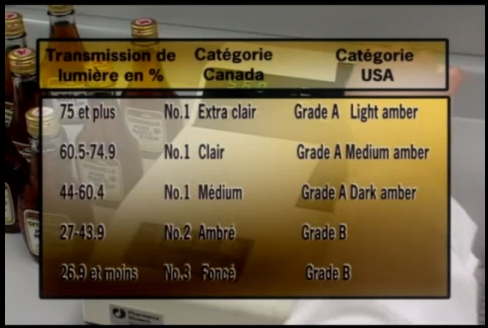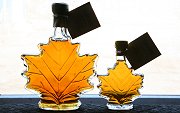This video presents “Maple syrup transformation facility – laboratory and quality control” in Quebec, Canada.
- “Looks at the high tech sampling and verification methods and maple syrup equipment used in the Citadelle Maple Syrup Producer’s Cooperative transformation plant for maple syrup grade classification and quality control.”

Image extracted from video above.
There are two types of classification for maple syrup: the federal government classification and that of the provincial governments.
- Quebec’s maple farmers have the option of complying with either of the two regulations in effect.
- Quebec maple producers are the main producers of maple syrup in Canada and the world, with 71% of world production (in 2004).
- According to the Federation of Quebec Maple Syrup Producers, the Canadian provinces that produce maple syrup are:
- Quebec (90.7% of domestic production),
- Ontario (4.4%),
- New Brunswick (4.4%),
- Nova Scotia (0.5%), and
- Prince Edward Island which also produces maple syrup, but in small quantities.
Nearly 85% of Quebec’s annual maple production is sold in bulk to processing companies or to buyers and exporters who redistribute maple products in bulk or prepackaged form.
- These products can be sold to grocery stores, supermarkets or gift shops, on both the domestic and international markets.
- In 2007, the value of the maple syrup crop was estimated at $136 M.
- An interesting note is that maple product exports increased 10% in 2006 and 13% in 2007.
Quebec is the largest exporter of maple products in Canada and the world, counting 96% (Quebec: $207.9 M; Canada: $217.5 M) of total Canadian sales abroad in 2007.
- That same year, maple products were sold in 48 countries.
- By order of importance, the largest importers of maple products are the United States, Germany and Japan.
The Current Federal Classification
The Canadian Food Inspection Agency (CFIA) governs the food safety and quality of maple products in Canada and is responsible for the “federal” classification of maple syrup.
- This current classification standard includes three categories and five grades of syrup:
- Canada #1 (Extra light, Light, Medium)
- Canada #2 (Amber)
- Canada #3 (Dark) and syrups from any other category with flavour flaws
Canadian producers are responsible for 84 per cent of world maple syrup production, with the United States responsible for 16 per cent.
Now, Canada is proposing amendments to the Maple Products Regulations in order to obtain the following results:
- harmonize the definition and grading system in the United States and Canada, and
- give consumers more consistent and relevant information about different varieties of maple syrup.
The new standards would result in the modernization of the current grades and colour classes of maple syrup introducing new flavour descriptors that will help consumers make more informed choices when buying maple syrup.
- The proposed amendments would replace the current grading system with two new grade names and standards, Canada Grade A and Canada Processing Grade, as well as the following four new colour classes for Canada Grade A maple syrup:
-
Golden Delicate
-
Amber Rich
-
Dark Robust
-
Very Dark Strong
-
- For example, four revised colour classes and new taste descriptors will categorize pure maple syrup on a scale ranging from “Golden Maple Syrup with a delicate taste” to “very Dark Maple Syrup with a strong taste”.
To help the Canadian maple industry transition to any new regulations resulting from this process, the CFIA is recommending a two-year transition period.
The proposed amendments to the Maple Products Regulations will be published in Canada Gazette, Part I on June 28, 2014.
- The CFIA is seeking input from consumers and industry on the proposed changes during the 75-day comment period, ending on September 10, 2014.

Image by Ontario Maple Syrup Producers Association.
NEWS RELEASE
Canadian Food Inspection Agency
Harper Government announces new proposed standards for Canadian maple syrup
Amendments support Canadian maple industry and consumer demand
June 27, 2014 – Ottawa, ON – Canadian Food Inspection Agency
The Government of Canada is proposing amendments to the Maple Products Regulations to set federal maple syrup standards that benefit consumers and industry.
The proposed changes would harmonize the definition and grading system in the United States and Canada, and give consumers more consistent and relevant information about different varieties of maple syrup.
The new standards would result in the modernization of the current grades and colour classes of maple syrup introducing new flavour descriptors that will help consumers make more informed choices when buying maple syrup. For example, four revised colour classes and new taste descriptors will categorize pure maple syrup on a scale ranging from “Golden Maple Syrup with a delicate taste” to “very Dark Maple Syrup with a strong taste”.
The proposed amendments to the Maple Products Regulations will be published in Canada Gazette, Part I on June 28, 2014. The CFIA is seeking input from consumers and industry on the proposed changes during the 75-day comment period, ending on September 10, 2014.
To help the Canadian maple industry transition to any new regulations resulting from this process, the CFIA is recommending a two-year transition period. This would allow industry to gradually implement any new requirements.
Quick Facts
- Canadian producers are responsible for 84 per cent of world maple syrup production, with the United States responsible for 16 per cent.
- These proposed amendments are based on recommendations from the International Maple Syrup Institute (IMSI) and feedback received during previous consultations with consumers and industry.
- The IMSI is a voluntary organization representing the Canadian and American maple syrup industries. The Institute has been working and consulting for several years on developing common grading standards for Canada and the United States.
- The Government of Canada is committed to providing more information for consumers so they can make informed food choices.
Quotes
“Canada is world renowned for its high-quality maple syrup and maple products. These proposed amendments will better support Canada’s maple producers by helping to facilitate trade and meet consumer demand.”
Gerry Ritz
Minister of Agriculture and Agri-Food
“Not only will these amendments provide maple producers greater freedom to market their products internationally, they will make it easier for Canadian consumers to purchase the syrup they prefer. The new grades and colour classes will help Canadians make more informed choices when shopping for our high quality maple syrup.”
Nancy Greene Raine
Senator
La vidéo: “Étapes de transformation à l’usine du sirop d’érable – laboratoire et contrôle qualité” au Québec, Canada.
- “Coup d’œil sur l’échantillonnage, les méthodes de vérification et sur l’équipement pour la cueillette du sirop d’érable utilisé par Citadelle, coopérative de producteurs de sirop d’érable, à son usine de transformation pour la classification d’érable du sirop et du contrôle de qualité.”
Communiqué de presse
Le gouvernement Harper annonce de nouvelles normes concernant le sirop d’érable canadien
Des modifications qui répondront aux demandes de l’industrie acéricole et des consommateurs canadiens
Le 27 juin 2014 – Ottawa (Ontario) – Agence canadienne d’inspection des aliments
Le gouvernement du Canada propose d’apporter des modifications au Règlement sur les produits de l’érable pour établir des normes fédérales en matière de sirop d’érable qui profiteront tant aux consommateurs qu’à l’industrie.
Les changements proposés permettraient d’harmoniser les systèmes de définitions et de classement des États-Unis et du Canada, et de donner aux consommateurs des renseignements plus cohérents et pertinents concernant les différentes variétés de sirop d’érable.
Les nouvelles normes permettraient de moderniser le système actuel de classement du sirop d’érable par catégorie et couleur grâce à la mise en place de nouveaux descripteurs de goût qui aideront les consommateurs à faire des choix plus éclairés au moment de l’achat de sirop d’érable. Par exemple, quatre classes de couleur révisées ainsi que de nouveaux descripteurs de goût permettront de classer le sirop d’érable pur selon une échelle de description allant de « Sirop d’érable de couleur dorée au goût délicat » à « Sirop d’érable de couleur très foncée au goût corsé ».
Le projet de modification du Règlement sur les produits de l’érable sera publié dans la Partie I de la Gazette du Canada le 28 juin 2014. L’ACIA invite les consommateurs et l’industrie à commenter les modifications proposées durant la période de consultation de 75 jours, qui prendra fin le 10 septembre 2014.
Pour aider l’industrie acéricole canadienne à s’adapter aux nouvelles exigences réglementaires qui découleront de ce processus, l’ACIA recommande une période de transition de deux ans. L’industrie pourrait ainsi mettre en oeuvre progressivement les nouvelles exigences.
En bref
- Les producteurs canadiens sont responsables de 84 p. 100 de la production mondiale de sirop d’érable; 16 p. 100 provient des États-Unis.
- Ces changements apportés par l’ACIA se fondent sur des recommandations de l’Institut international du sirop d’érable (IISE) et les commentaires reçus durant des consultations antérieures auprès des consommateurs et de l’industrie.
- L’IISE est une organisation bénévole représentant les industries acéricoles du Canada et des États-Unis. Depuis plusieurs années, l’IISE travaille à l’élaboration de normes communes de classement pour les États-Unis et le Canada.
- Le gouvernement du Canada est déterminé à donner plus d’information aux consommateurs pour qu’ils puissent faire des choix éclairés concernant les aliments qu’ils achètent.
Citation
« Le Canada est reconnu pour la grande qualité de son sirop d’érable et des produits dérivés. Ce projet de modification aidera les producteurs acéricoles canadiens à faciliter les échanges et à répondre aux demandes des consommateurs. »
Gerry Ritz
Ministre de l’Agriculture et de l’Agroalimentaire
« Grâce à ces modifications, non seulement les producteurs de produits de l’érable auront plus de liberté pour commercialiser leurs produits sur les marchés internationaux, mais il sera plus facile pour les consommateurs canadiens d’acheter le sirop qu’ils préfèrent. Les nouvelles catégories et classes de couleur aideront les Canadiens à faire des choix plus éclairés au moment de l’achat de notre sirop d’érable de qualité supérieure ».
Nancy Greene Raine
Sénatrice
————————————–
You may also want to know:
- McAfee: Superstar Soccer Players’ Screensavers and “Skills” Video Downloads are Risky to Search for Online (McAfee’s FREE SiteAdvisor)
- Photography Copyright Kit (FREE)
- Olympus ‘Anywhere Classroom’ Video Series Starts June 26, 2014: An Online FREE Photography Class Using Olympus OM-D Cameras & Lenses
- You’re Invited to Magnetic North Exhibtion Until July 19, 2014: Photographs, Artifacts & Contemporary Canadian Art of the Arctic (FREE Admission)
- You’re Invited: Doors Open Ontario May 3 – October 18, 2014 (FREE admission)
- FUJIFILM Canada Announces “Walk in the Park” Tour with the Fuji Guys and L’Expert Fuji 2014 (FREE Admission: Victoria, September 20) *Dates are subject to change
- You’re Invited: Download Leica Fotografie International App for iPhone, iPod Touch, iPad and Android
- Union Station Closure Apr.5 – 7 Before 6 A.M.+ Closures of Gardiner Expressway Start Apr.25, 2014 (Toronto, Ontario, Canada)
- Toronto’s Transit Relief Line & Yonge Relief Network Study Consultations Apr.5, 8, 10,12, 2014 (or provide your feedback online)
